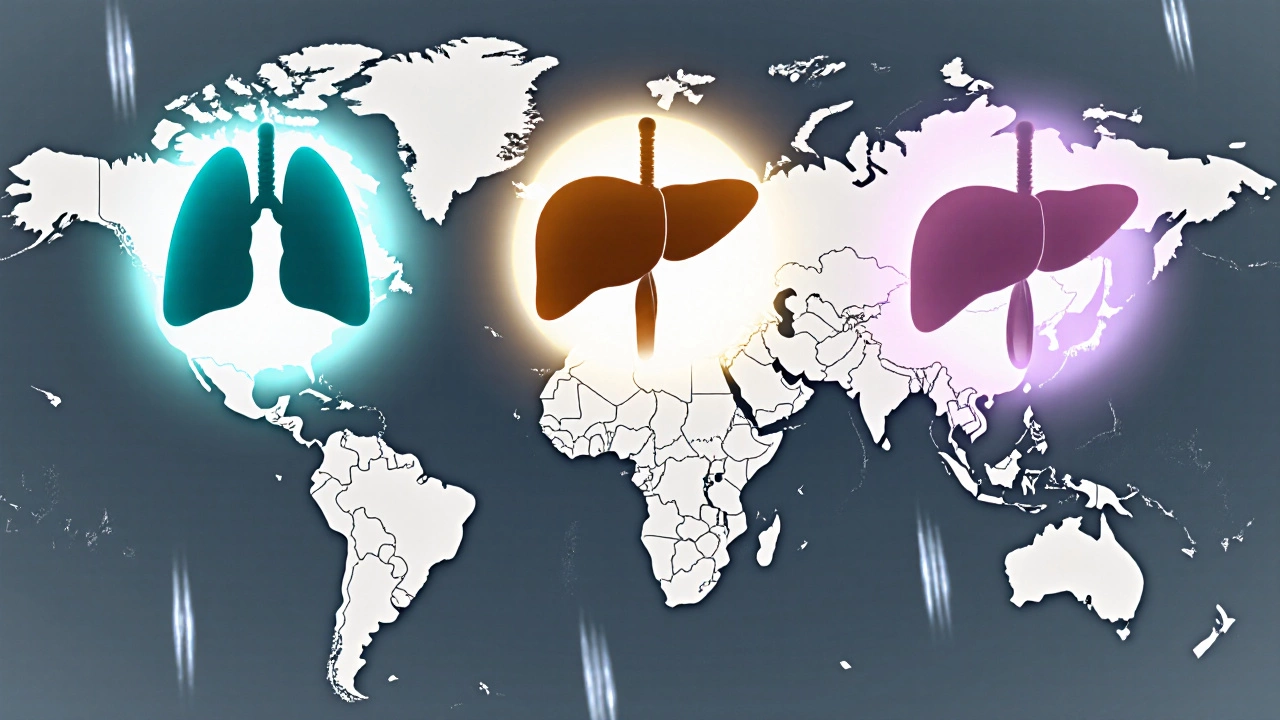Deadliest Cancer Comparison Tool
Compare Cancer Mortality Metrics
Compare the top 3 deadliest cancers based on WHO/IARC data. Toggle between different metrics to see how each cancer performs.
When it comes to mortality, Deadliest Cancers are a group of cancers that claim the most lives each year worldwide. Understanding why these three cancers-Lung Cancer, Liver Cancer, and Pancreatic Cancer- dominate the statistics helps patients, families, and clinicians focus on early detection and effective treatment.
Why mortality rates matter more than incidence
Incidence tells you how many new cases appear, but mortality reveals how many people actually die. A cancer with a high incidence but low death count usually means early detection and effective therapy are available. Conversely, a low‑incidence tumor that kills quickly is a red flag for aggressive biology and limited treatment options. For the three cancers we’ll cover, both incidence and death tolls are alarmingly high, making them the true "deadliest" in global health terms.
How we rank the deadliest cancers
We use three core metrics from the World Health Organization (WHO) and the International Agency for Research on Cancer (IARC) for 2023‑2024 data:
- Number of deaths per year (absolute mortality)
- Case‑fatality ratio (deaths ÷ new cases, expressed as %)
- 5‑year survival rate (percentage of patients still alive five years after diagnosis)
Putting these together highlights cancers that are both common and hard to treat.
Quick comparison of the top 3 deadliest cancers
| Cancer | New Cases (millions) | Deaths (millions) | Case‑Fatality % | 5‑Year Survival % |
|---|---|---|---|---|
| Lung Cancer | 2.2 | 1.8 | 82 | 20 |
| Liver Cancer | 0.9 | 0.8 | 89 | 15 |
| Pancreatic Cancer | 0.5 | 0.5 | 100 | 9 |

1. Lung Cancer
Lung cancer accounts for the highest number of cancer deaths worldwide-about 1.8 million in 2024. The disease is split into two main types: small‑cell lung carcinoma (SCLC) and non‑small‑cell lung carcinoma (NSCLC), the latter representing roughly 85 % of cases.
Key risk factors
- Smoking (responsible for ~85 % of cases)
- Second‑hand smoke exposure
- Air pollution and occupational dust (asbestos, silica)
- Genetic predisposition (e.g., EGFR mutations)
Typical symptoms
- Persistent cough or hoarseness
- Shortness of breath
- Chest pain that worsens with deep breathing
- Unexplained weight loss
Current treatment landscape
Oncology teams combine Chemotherapy, targeted therapy (EGFR, ALK inhibitors), Radiation Therapy, and newer Immunotherapy (PD‑1/PD‑L1 blockers). Early‑stage disease may be cured with surgery, but 70 % of patients present at an advanced stage, limiting curative options.
Prevention tips
- Quit smoking-nicotine‑replacement or counseling improves survival even after diagnosis.
- Reduce exposure to indoor pollutants; use air purifiers and avoid smoking indoors.
- Screen high‑risk adults (age 55‑80, 30+ pack‑years) with low‑dose CT scans every year.
2. Liver Cancer
Liver cancer-primarily hepatocellular carcinoma (HCC)-claims roughly 800,000 lives each year. It ranks third in cancer mortality despite a lower incidence than lung cancer because it often arises in a chronically diseased liver.
Key risk factors
- Chronic hepatitis B or C infection
- Alcohol‑related cirrhosis
- Non‑alcoholic fatty liver disease (NAFLD) linked to obesity and diabetes
- Aflatoxin exposure (contaminated grains)
Typical symptoms
- Right‑upper‑abdomen pain or fullness
- Jaundice (yellowing of skin/eyes)
- Unexplained weight loss
- Ascites (abdominal fluid buildup)
Current treatment landscape
Early‑stage HCC can be cured with surgical resection, liver transplantation, or ablative techniques (radiofrequency ablation). For intermediate disease, trans‑arterial chemo‑embolization (TACE) is standard. Advanced HCC now benefits from targeted agents such as sorafenib and lenvatinib, plus immunotherapy combos (atezolizumab + bevacizumab) that have pushed 1‑year survival above 70 %.
Prevention tips
- Vaccinate infants and at‑risk adults against hepatitis B.
- Screen chronic hepatitis carriers with ultrasound and AFP every 6 months.
- Limit alcohol intake and maintain a healthy weight to reduce NAFLD risk.

3. Pancreatic Cancer
Pancreatic cancer is the most lethal solid tumor, with a 5‑year survival of just 9 % and almost as many deaths as new cases (≈500,000 each). Its stealthy nature and deep abdominal location delay diagnosis.
Key risk factors
- Smoking (doubles risk)
- Chronic pancreatitis
- Family history of BRCA2 or PALB2 mutations
- Obesity and long‑term diabetes
Typical symptoms
- Persistent upper‑abdominal pain radiating to the back
- New‑onset diabetes or worsening blood sugar control
- Jaundice (especially in tumors near the bile duct)
- Unexplained weight loss and loss of appetite
Current treatment landscape
Surgery (Whipple procedure) offers the only chance of cure, but only 15‑20 % of patients qualify at diagnosis. For most, systemic therapy-combination Chemotherapy (FOLFIRINOX or gemcitabine + nab‑paclitaxel) plus Immunotherapy for MSI‑high tumors-remains standard. Clinical trials focusing on stromal targeting and vaccine approaches are ongoing.
Prevention tips
- Quit smoking; risk drops to baseline within 10 years of cessation.
- Maintain a healthy BMI and manage diabetes rigorously.
- Consider genetic counseling if you have a strong family history; early screening with endoscopic ultrasound may be offered.
Practical checklist for early detection
- Know your personal and family risk factors for each cancer.
- Stay up‑to‑date with recommended screening tests:
- Low‑dose CT for high‑risk smokers (age 55‑80).
- Biannual ultrasound + AFP for chronic hepatitis B/C.
- Discuss pancreatic imaging if you develop new diabetes after age 50.
- Adopt lifestyle habits that lower risk: no tobacco, limited alcohol, balanced diet, regular exercise.
- Seek medical attention promptly for unexplained persistent symptoms listed above.
What the future holds
Advances in genomics, liquid‑biopsy blood tests, and AI‑driven imaging are expected to shift these cancers from "late‑stage" to "detectable‑early" within the next decade. Meanwhile, combination immunotherapies are already extending survival for liver and lung cancer patients. Staying informed about clinical trials can give patients access to cutting‑edge treatments before they become standard of care.
Why is the 5‑year survival rate so low for pancreatic cancer?
Pancreatic tumors grow inside the abdomen, so they often cause no symptoms until they block the bile duct or spread to nearby organs. By the time pain, jaundice, or weight loss appear, the disease is usually advanced and not removable by surgery.
Can liver cancer be prevented?
Yes, to a large extent. Vaccinating against hepatitis B, treating chronic hepatitis C, avoiding aflatoxin‑contaminated foods, limiting alcohol, and managing obesity all dramatically cut the risk of developing hepatocellular carcinoma.
Is low‑dose CT screening safe for smokers?
Low‑dose CT uses about 1/10th the radiation of a regular chest CT, making the cancer‑detection benefit outweigh the small radiation risk for high‑risk smokers. Guidelines advise annual scans for those aged 55‑80 with a 30‑pack‑year smoking history.
What role does immunotherapy play in treating these cancers?
Immunotherapy drugs such as pembrolizumab (PD‑1 inhibitor) boost the body’s immune response. They have become first‑line for advanced non‑small‑cell lung cancer with high PD‑L1 expression and are now combined with anti‑angiogenic agents for liver cancer, extending median survival beyond one year.
Should I get genetic testing for pancreatic cancer risk?
If you have a close relative with pancreatic, breast, ovarian, or prostate cancer, especially before age 50, discuss BRCA2, PALB2, or CDKN2A testing with a genetic counselor. Positive results can lead to earlier surveillance and lifestyle changes.
